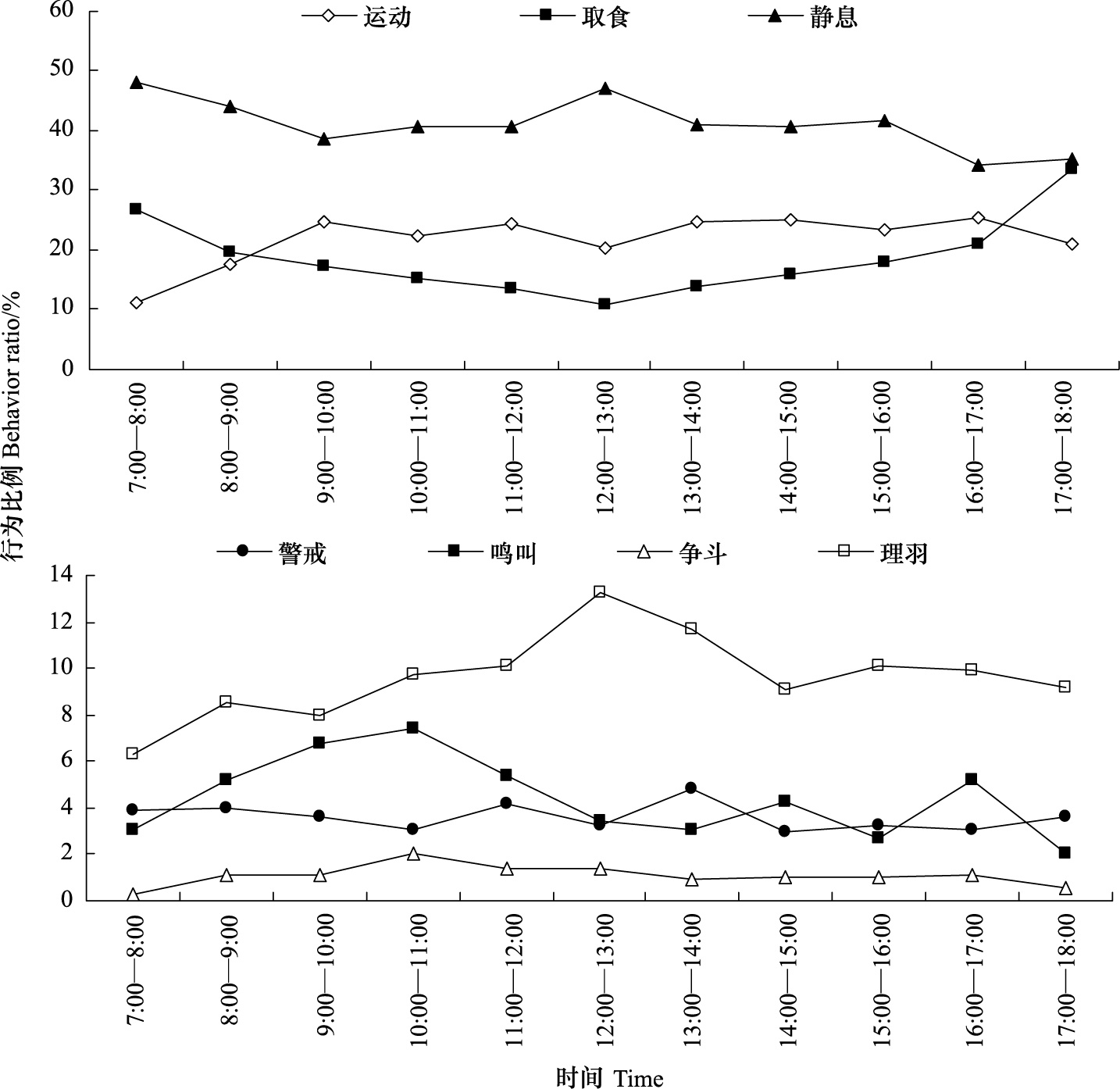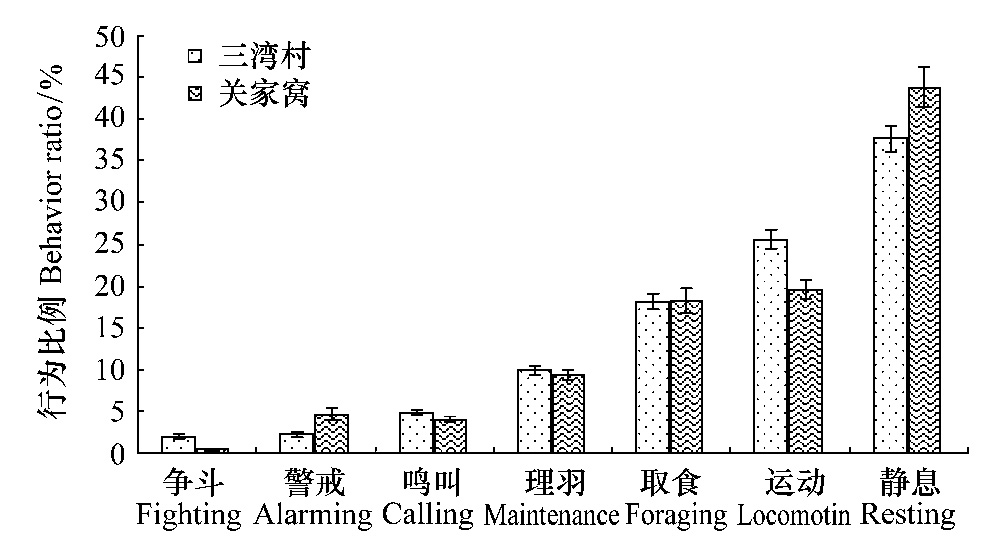文章信息
- 董超, 张国钢, 陆军, 李新平, 马俏飞, 侯韵秋, 关丙役
- DONG Chao, ZHANG Guogang, LU Jun, LI Xinping, MA Qiaofei, HOU Yunqiu, GUAN Bingyi
- 山西平陆越冬大天鹅日间行为模式
- Diurnal activity patterns of Whooper Swan wintering at Pinglu, Shanxi,China
- 生态学报, 2015, 35(2): 290-296
- Acta Ecologica Sinica, 2015, 35(2): 290-296
- http://dx.doi.org/10.5846/stxb201303230494
-
文章历史
- 收稿日期:2013-03-23
- 修订日期:2014-10-27
2. 山西省自然保护区管理站, 太原 030012;
3. 山西省平陆县林业局, 平陆 044300
2. Station of Shanxi National Nature Reserve, Taiyuan 030012, China;
3. Forest Bureau of Pinglu, Pinglu 044300, China
活动节律和行为时间分配是动物学研究中的重要内容[1]。水鸟的行为时间分配和活动节律受到多方面因素的影响,包括温度、栖息地类型、食物丰富度、干扰水平、隐蔽程度等[2, 3, 4, 5, 6, 7]。对越冬水鸟进行时间分配和活动节律的研究有助于了解越冬水鸟的行为策略和它们对关键生态因子的要求[8]。目前,国内外对水鸟的行为生态学研究理论较为丰富。Tamisier认为,鸟类会在较冷的时段增加取食,在较温暖的时段休息和理羽[9]。而John在对咳声天鹅(Cygnus buccinator)的研究中发现,当外界温度降低时,咳声天鹅会减少取食的时间而增加睡眠时间[10]。这两种不同的结论表明,当外界环境条件改变时,活动节律和行为时间分配也会随之改变[11]。
大天鹅(Cygnus cygnus)属雁形目鸭科天鹅属[12]。在我国主要的越冬地包括天津及河北沿海、山东荣成、东营、埕口,黄河中下游湿地、甘肃、青海、新疆等。目前,国内外对大天鹅的研究工作主要包括:数量和分布调查[13, 14, 15, 16]、行为生态学研究[17, 18, 19, 20, 21]、食性分析[22, 23]迁徙规律[24]和疫病研究[25, 26, 27]等方面。根据2011—2013 年的越冬种群数量调查,在山西平陆黄河湿地越冬的大天鹅数量可以到达2000 只左右,每年都会有大量游客聚集,人为干扰强度较大。那么,这些人为干扰如何影响大天鹅的活动节律和行为时间分配?温度的变化会对大天鹅的行为时间分配产生怎样的影响?基于此,于2011 年12 月至2012 年2 月和2012 年11 月至2013 年1 月,对山西平陆黄河湿地的大天鹅的越冬行为进行了研究,主要目的在于:(1)揭示大天鹅越冬行为的时间分配和活动节律(2)分析在不同干扰强度下大天鹅的行为差异(3)探讨温度对大天鹅行为时间分配的影响。
1 研究地点与方法 1.1 研究地点山西平陆黄河湿地地处山西省南部与河南省三门峡市交界的黄河流域,海拔325 m—337 m。本次研究的地点选择在位于山西平陆黄河湿地的三湾村(N34°49′48″ E111°9′17″)和关家窝村(N34°49′6″ E111°8′21″)两处(图 1)。两处的生境类型较为相似,皆为河流和冬小麦农田。三湾村每日游客数量较多,人为干扰强度大;关家窝村相对偏僻,人为干扰强度小。平陆县属暖温带大陆性气候,据县气象局历年统计资料记载,年降水量为570 mm,年平均气温13.1 ℃,冬季最冷的月份为1月,平均气温为-0.5 ℃。

|
| 图 1 山西平陆黄河湿地示意图 Fig. 1 The map of the Yellow River wetland at Pinglu of Shanxi,China |
根据2011—2013年的统计调查,在山西平陆黄河湿地越冬的主要水鸟除大天鹅外,还包括灰鹤(Grus grus)、苍鹭(Ardea cinerea)、大白鹭(Ardea albus)、白鹭(Egretta garzetta)、夜鹭(Nycticorax nycticorax)、普通鸬鹚(Phalacrocorax carbo)、灰雁(Anser anser)、豆雁(A. fabalis)、绿头鸭(Anas platyrhynchos)、斑嘴鸭(A.poecilorhyncha)、赤麻鸭(Tadorna ferruginea)、翘鼻麻鸭(T. tadorna)、凤头潜鸭(Aythya fuligula)、红头潜鸭(A. ferina)、普通秋沙鸭(Mergus merganser)、骨顶鸡(Fulica atra)等。
1.2 研究方法 1.2.1 记录方法利用单筒望远镜对大天鹅的行为进行观察。采用瞬时扫描法[6, 7, 28, 29, 30, 31],每隔10min扫描1次,一次记录10只大天鹅的行为类型,每次观察时间的长度以看清每只大天鹅的行为类型为止。每日的取样时间为7:00—18:00。在观察记录的同时,利用煤油温度计测量当地的温度情况(精确到1℃),以每日6:00、12:00、18:00的温度平均值作为日间平均气温。本次研究共计观察67 d(三湾村36 d、关家窝村31 d),有效扫描取样2305 次,得到有效行为数据23050个。其中,三湾村的有效数据为12940个,关家窝村的有效数据为10110个。记录的最低平均气温为-5 ℃,最高平均气温为9 ℃,将平均气温相同的日期下的行为进行统计归类。
1.2.2 行为分类取食:包括倒立探食、水面滤食、草地上觅食等。
静息:睡觉或静止不动。睡觉时头颈通常向后转,喙前端常埋于翅下。
运动:包括在水中游动、陆上或冰上行走和空中飞行。
理羽:用喙整理身体各部羽毛,还包括展翅、振翅、整理足部、在水中沐浴等。
警戒:头抬起,对周围的环境进行扫描,头部带有转动动作。干扰较强时会注视干扰源。
争斗:相互展翅、啄咬和追逐。
鸣叫:发出类似“ho-ho-”或“hour-”的鸣叫声。
1.2.3 数据处理将各种行为数据和气温数据输入到Excel 2003进行整理和统计。采用卡方检验,检验大天鹅在不同时间段的行为差异和不同观察地点下的总体行为差异。利用非参数检验中的Mann Whitney U 检验,检验各种行为类型在不同观察地点是否存在显著差异性。在大天鹅行为时间分配和温度变化的研究中,利用Pearson相关性分析检验温度与各行为的相关性。所有数据的分析过程全部在SPSS 18.0软件中进行。
2 结果 2.1 大天鹅日间行为时间分配大天鹅在越冬期的主要行为是静息行为,占全部行为比例的(40.5±1.4)%,其次是运动行为,占(22.8±0.9)%,第三是取食行为,占(18.2±0.8)%。理羽、鸣叫、警戒和争斗行为所占比例较少(图 2)。

|
| 图 2 山西平陆越冬大天鹅日间活动时间分配 Fig. 2 Diurnal activity budget of wintering Whooper Swan at Pinglu of Shanxi,China |
如图 3,大天鹅的取食高峰出现在7:00—8:00和17:00—18:00,低峰出现在12:00—13:00。静息高峰出现在7:00—8:00和12:00—13:00,低峰出现在16:00—18:00。运动、理羽、鸣叫和争斗的低峰均出现在7:00—8:00。其中,理羽的高峰出现在12:00—13:00,鸣叫和争斗的高峰出现在10:00—11:00。x2检验表明,除争斗行为(x2=17.17,df=10,P=0.071)外,其他各行为的日节律均有极显著差异(x2=31.72—405.65,df=10,P=0.000)。

|
| 图 3 山西平陆大天鹅行为活动日节律 Fig. 3 Diurnal rhythm of the wintering Whooper Swan at Pinglu of Shanxi,China |
如图 4,三湾村和关家窝村的大天鹅在取食时间上相似((18.3±1.4)%、(18.1±0.9)%),三湾村大天鹅的运动和争斗行为((25.6±1.1)%、(1.9±0.3)%)高于关家窝村((19.6±1.2)%、(0.4±0.1)%},静息和警戒行为((37.7±1.5)%、(2.2±0.3)%}则低于关家窝村((43.8±2.4)%、(4.6±0.7)%)。x2检验表明,两处大天鹅的行为时间分配存在极显著差异(x2=353.31,df=6,P=0.000)。经Mann Whitney U 检验表明,大天鹅的静息(U=400,P=0.047)、运动(U=292.5,P=0.001)、警戒(U=380.5,P=0.025)和争斗(U=193,P=0.000)行为在不同地点下存在显著差异。取食(U=534.5,P=0.768)、理羽(U=515,P=0.588)和鸣叫行为(U=421,P=0.085)则无显著差异。

|
| 图 4 山西平陆大天鹅在不同地点的时间分配 Fig. 4 Activity budget of the wintering Whooper Swan in different villages at Pinglu of Shanxi,China |
如图 5,大天鹅的取食、运动和理羽行为随着温度的升高呈现上升趋势;静息和警戒行为随着温度的升高呈现下降趋势;鸣叫和争斗行为随温度变化的趋势不明显。Pearson相关性分析表明,大天鹅的取食(R=0.932,P=0.000)、理羽(R=0.792,P=0.002)和运动(R=0.581,P=0.023)行为与温度呈现显著正相关;静息(R=-0.814,P=0.000)和警戒行为(R=-0.807,P=0.000)与温度呈现显著负相关;鸣叫(R=0.228,P=0.414)和争斗(R=0.292,P=0.290)行为与温度的相关性不显著(表 1)。

|
| 图 5 山西平陆大天鹅越冬行为随温度的变化 Fig. 5 Behavior changes with temperature of wintering Whooper Swan at Pinglu of Shanxi,China |
| 温度影响 Temperature effect | 取食 Foraging | 静息 Resting | 运动 Locomotion | 警戒 Alarming | 鸣叫 Calling | 理羽 Maintenance | 争斗 Fighting | |
| 相关系数 | R | 0.932 | -0.814 | 0.581 | -0.807 | 0.228 | 0.792 | 0.292 |
| Correlation coefficient | P | 0.000 | 0.000 | 0.023 | 0.000 | 0.414 | 0.002 | 0.290 |
越冬期大天鹅的静息行为比例高于取食和运动,这种行为分配模式与侯栋皓[29]、John[10]和Wlodzimierz[32]分别对越冬大天鹅、咳声天鹅(C.buccinator)和疣鼻天鹅(C.olor)的研究结论一致。Bortner等[33]对啸声天鹅(C.columbianus)的研究发现,即使在食物充足的条件下,啸声天鹅在越冬期的体重仍然会下降。由此推断,天鹅的越冬行为策略并不是以大量取食的方式来增加能量储存,而是通过增加静息时间,降低自身的能量消耗,这与其它中小型雁鸭类(如斑头雁[7]、白额雁[34]、中华秋沙鸭[30])、鹤类(如黑颈鹤[6, 31, 35]、灰鹤[36]、丹顶鹤[37])的越冬行为策略不同。Jalene等[38]的研究表明,咳声天鹅会在春季的停歇地增加取食时间,弥补越冬期的能量消耗,为繁殖做好准备。另外,冬季光照时间的缩短,也可能是造成水鸟取食时间变短的原因[39],今后将进一步进行深入研究。
就取食和静息两种行为而言,平陆大天鹅的取食时间和静息时间均略低于侯栋皓[29]和John[10]的研究结果,原因可能是食物质量和人为干扰问题。平陆大天鹅除可以取食水中的水生植物外,还可以取食地里的冬小麦和游客投喂的玉米、面包,而冬小麦(40—46)×4.18kJ/100 g)、玉米((192—198)×4.18kJ/100 g)和面包(246×4.18kJ/100 g)的热量均高于低质量的水生植物(38—42×4.18kJ/100 g)。因此,平陆大天鹅可以在相对较低的取食时间内满足自身的能量需求。同时,相对较大的干扰强度也会降低大天鹅的取食和静息时间。
3.2 大天鹅日间活动节律早晚双高峰型的取食行为有利于大天鹅更好的应对夜间的能量消耗,这种行为策略在鸟类学研究中十分常见[40, 41]。通常早上的气温较低,为了降低自身的能量消耗,大天鹅会减少运动行为,而增加静息行为,这使得早上会同时出现取食、静息的高峰和运动的低峰。另一个静息高峰和理羽高峰出现在中午,这与孔德军等[6]对黑颈鹤的研究结果相似。同时,中午游客数量相对较少,也为大天鹅的静息提供了条件。警戒行为的高峰分别出现在早上和中午,与大天鹅静息行为的日节律一致,原因可能是大天鹅在静息时很容易受到天敌的威胁,这时,一部分大天鹅会作为警戒天鹅来守护鹅群,一旦发现敌害威胁,它们便用鸣叫的方式提醒同伴,对外来威胁迅速做出反应。
3.3 不同地点的行为差异动物对干扰的反应会随着时间、地点和干扰类型的不同而变化[42]。三湾村和关家窝村的大天鹅在取食时间上相似。与关家窝村相比,三湾村大天鹅的运动时间相对较高,静息时间相对较低。导致这一结果的原因可能有以下两点:一是三湾村的人为干扰较大,导致大天鹅的运动行为增多,影响了大天鹅的静息时间;二是三湾村的大天鹅除取食水生植物和冬小麦外,还会取食游客投喂的玉米和面包。因此,在取食时间相同的情况下,三湾村的大天鹅获得了更多的能量,而关家窝村的大天鹅则只能通过增加静息时间来弥补取食质量上的不足。投食会导致大天鹅聚集,取食密度较大时会发生种内竞争,引起争斗,这解释了为什么三湾村大天鹅的争斗行为明显高于关家窝村。动物在受干扰时的反应可视为其对潜在捕食风险的权衡[43],长期的人为干扰会使动物产生适应性[44],三湾村的大天鹅长期生活在人为干扰下,对干扰产生了一定的适应性,这可能是三湾村大天鹅警戒率相对较低的原因。人为干扰改变了大天鹅的行为时间分配,带来的影响可能是多方面的。一方面,人为投食提高了大天鹅的取食效率,使得大天鹅可以在相对较短的时间内满足自身的能量需求。另一方面,长期的人为干扰使得大天鹅产生了适应性,这可能会降低大天鹅在野外的警惕性,增加它们被捕杀的风险。投食也会增加种内的斗争频率,改变个体间的等级关系。Goodall等[45]的研究表明,动物体长期接受人工投食后,一旦停止投食,动物体可能会因不再适应自然环境而死亡。对于幼体大天鹅来说,长期取食人类投喂的食物可能会导致自身觅食能力的下降,而在迁徙过程中被淘汰。
3.4 温度对大天鹅行为时间分配的影响低温下,水鸟可能会放弃包括取食在内的行为活动,从而降低自身的能量消耗[46]。大天鹅的取食行为与温度呈现显著正相关,静息行为呈现显著负相关,这与John[10]的研究结果一致,表明当温度下降时,大天鹅会减少取食行为,增加静息行为,从而降低自身的能量消耗。另外,当温度低于0 ℃时,部分河面开始结冰,缩减了大天鹅的取食范围,这也可能是大天鹅取食比例下降、静息比例升高的原因。运动和理羽行为与温度同样呈现显著正相关,当温度下降时,减少运动行为可以有效地降低自身能量的消耗;当温度升高时,大天鹅可以通过增加运动行为寻找觅食场所,补充能量。而在运动的同时进行理羽,有助于大天鹅放松身体,缓解运动疲劳。警戒行为与温度呈现显著负相关,这与静息行为一致,再次验证了,当大天鹅静息时,鹅群中会增加警戒天鹅的数量,以保证大天鹅群体的安全。
3.5 保护意见据新华社2009 年的新闻报道,平陆黄河湿地曾发生毒害大天鹅的恶劣事件,导致越冬大天鹅数量骤减。随着当地政府的严格执法和村民保护大天鹅意识的增强,在平陆越冬的大天鹅数量开始逐渐恢复。但近几年,为了发展当地经济,村民在三湾村的湿地中开发鱼塘,进行捕鱼作业。同时,为了吸引更多游客,在大天鹅的投食点附近开设收费停车场,供游客停车。建议保护区及时采取管理措施,禁止渔船在越冬期作业,严格控制游客和机动车数量,及时查处猎捕、投毒等违法行为,为越冬大天鹅提供一个理想的栖息环境,确保大天鹅安全越冬。
| [1] | Halle S, Stenaeth N C. Activity Patterns in Small Mammals: An Ecological Approach. New York, Heidelberg: Springer-Verlag, 2000. |
| [2] | Turnbull R E, Baldassarre G A. Activity budgets of mallards and American Wigeon wintering in east-central Alabama. The Wilson Bulletin, 1987, 99(3): 457-464. |
| [3] | Nilsson L. Food-seeking activity of south Swedish diving ducks in the non-breeding season. Oikos, 1970, 21(2): 145-154. |
| [4] | Rave D P, Baldassarre G A. Activity budget of Green-winged teal wintering in coastal wetlands of Louisiana. The Journal of Wildlife Management, 1989, 53(3): 753-759. |
| [5] | Paulus S L. Activity budgets of non-breeding Gadwalls in Louisiana. The Journal of Wildlife Management, 1984, 48(2): 371-380. |
| [6] | 孔德军, 杨晓君, 钟兴耀, 道美标, 朱勇. 云南大山包黑颈鹤日间越冬时间分配和活动节律. 动物学研究, 2008, 29(2): 195-202. |
| [7] | 杨延峰, 张国钢, 陆军, 刘文, 李振吉. 贵州草海越冬斑头雁日间行为模式及环境因素对行为的影响. 生态学报, 2012, 32(23): 7280-7288. |
| [8] | Baaziz N, Samraoui B. The status and diurnal behavior of wintering common coot Fulica Atra in the Hauts Plateaux, Northeast Algeria. European Journal of Scientific Research, 2008, 23(3): 495-512. |
| [9] | Tamisier A. Diurnal activities of Green-winged Teal and Pintail wintering in Louisiana. Wildfowl, 1976, 27: 19-32. |
| [10] | Squires J R, Anderson S H. Changes in trumpeter swan (Cygnus buccinator) activities from winter to spring in the greater Yellowstone Area. The American Midland Naturalist, 1997, 138(1): 208-214. |
| [11] | Caraco T. Time budgeting and Group size: a test of theory. Ecology, 1979, 60(3): 618-627. |
| [12] | 郑光美. 中国濒危动物红皮书: 鸟类. 北京: 科学出版社, 1988: 38-39. |
| [13] | Leif N. Numbers of mute swan and whooper swan in Sweden, 1967-2000. Waterbirds, 2001, 25(S1): 53-60. |
| [14] | Luigujöe L, Kuresoo A, Leivits A. Numbers and distribution of whooper swans breeding, wintering and on migration in Estonia, 1990-2000. Waterbirds, 2001, 25(S1): 61-66. |
| [15] | Dmitrijs B, Hakon K P. Winter distribution of whooper swans Cygnus cygnus cygnets bred in Latvia, 2004-2008. Wildfowl, 2011, 61: 74-89. |
| [16] | Peter A C, Kendrew C, Einarsson O, McElwaine J G, Gardarsson A, Pollitt M S, Rees E C. The status and distribution of the Icelandic whooper swan population: Results of the international whooper swan census 2000. Waterbirds, 2002, 25(S1): 37-48. |
| [17] | Jeffrey M B, Eileen C R. The structure and behaviour of the Whooper Swan population wintering at Caerlaverock, Dumfries and Galloway, Scotland: an introductory study. Wildfowl, 1984, 35: 21-36. |
| [18] | O'Donoghue P D, O'Halloran J. The behaviour of a wintering flock of whooper swans at Rostellan Lake, Cork. Royal Irish Academy, 1994, 94(2): 109-118. |
| [19] | Rees E C, Bruce J H, White G T. Factors affecting the behavioural responses of whooper swans (cygnus c. cygnus) to various human activities. Biological Conservation, 2005, 121(3): 369-382. |
| [20] | Chisholm H, Spray C. Habitat usage and field choice by mute and whooper swans in the Tweed Valley, Scotland. Waterbirds, 2002, 25(S1): 177-182. |
| [21] | Rees E C, Kirby J S, Gilburn A. Site selection by swans wintering in Britain and Ireland. IBIS, 1997, 139(2): 337-352. |
| [22] | Squires J R, Anderson S H. Trumpeter swan (Cygnus buccinator) food habits in the Greater Yellowstone Ecosystem. American Midland Naturalist, 1995, 133(2): 274-282. |
| [23] | 董翠玲, 齐晓丽, 刘建. 荣成天鹅湖湿地越冬大天鹅食性分析. 动物学杂志, 2007, 42(6): 53-56. |
| [24] | Scott H N, Samuel A I, John Y T. Migration of whooper swans and outbreaks of highly pathogenic avian influenza H5N1 virus in Eastern Asia. PLoS ONE, 2009, 4(5): 1-10. |
| [25] | Teifke J P, Klopfleisch R, Globig A, Starick E, Hoffmann B, Wolf P U, Beer M, Mettenleiter T C, Harder T C. Pathology of natural infections by H5N1 highly pathogenic avian influenza virus in mute (Cygnus olor) and Whooper (Cygnus cygnus) Swans. Veterinary Pathology, 2007, 44(2): 137-143. |
| [26] | Uchida Y, Mase M, Yoneda K, Kimura A, Obara T, Kumagai S, Saito T, Yamamoto Y, Nakamura K, Tsukamoto K, Yamaguchi S. Highly pathogenic avian influenza virus (H5N1) isolated from whooper swans, Japan. Emerging Infectious Diseases, 2008, 14(9): 1427-1429. |
| [27] | Brown J D, Stallknecht D E, Swayne D E. Experimental infection of swans and geese with highly pathogenic avian influenza virus(H5N1)of Asian Lineage. Emerging Infectious Diseases, 2008, 14(1): 136-142. |
| [28] | 张国钢, 梁伟, 楚国忠. 海南黑脸琵鹭的越冬行为分析. 生物多样性, 2006, 14(4): 352-358. |
| [29] | 侯栋皓, 刘昕. 荣成沿海越冬大天鹅行为的数量化分析. 中国科技论文在线. |
| [30] | 易国栋, 杨志杰, 刘宇, 左斌, 赵匠, 郝锡联. 中华秋沙鸭月越冬行为时间分配及日活动节律. 生态学报, 2010, 30(8): 2228-2234. |
| [31] | 仓决卓玛, 杨乐, 李建川. 西藏黑颈鹤越冬期昼间行为的时间分配. 野生动物杂志, 2008, 29(1): 15-20. |
| [32] | Wlodzimierz M. Behaviour of mute swans Cygnus olor wintering at a municipal beach in Gdynia, Poland. Ornis Svecica, 2007, 17: 148-153 |
| [33] | Bortner J B. Bioenergetics of Wintering Tundra Swans in the Mattamuskeet Region of North Carolina [D]. Maryland: University of Maryland, 1985. |
| [34] | Owen M. Some factors affecting food intake and selection in white-fronted geese. The Journal of Animal Ecology, 1972, 41(1): 79-92. |
| [35] | 李凤山, 马建章. 越冬黑颈鹤个体行为生态的研究. 生态学报, 2000, 20(2): 293-298. |
| [36] | 刘小葛, 刘婧, 张文, 刘宁. 拉市海灰鹤越冬后期的日活动行为时间分配及食性分析. 西部林业科学, 2009, 38(3): 76-80. |
| [37] | 吕士成, 陈卫华. 环境因素对丹顶鹤越冬行为的影响. 野生动物杂志, 2006, 27(6): 18-20. |
| [38] | Jalene M L, Robert M R. Trumpeter swan behavior at spring-migration stopover areas in southern Alberta. Canadian Journal of Zoology, 2001, 79: 2036-2042. |
| [39] | Systad G H, Bustnes J O, Erikstad K E. Behavioral responses to decreasing day length in wintering Sea Ducks. The Auk, 2000, 117(1): 33-40. |
| [40] | Lees J. Winter feeding hours of Robins, Blackbirds, and Blue Tits. Brit Birds, 1948, 41(4099): 71-76. |
| [41] | Gibb J. Food feeding habits and territory of the Rock Pipit, Anthus spinoletta. Ibis, 1956, 98(3): 506-530. |
| [42] | Eileen C R, Jennifer H B. Factors affecting the behavioural responses of Whooper Swans (Cygnus c. cygnus) to various human activities. Biological Conservation, 2005, 121(3): 369-328. |
| [43] | Gill J A, Sutherland W H. A method to quantify the effects of human disturbance on animal population. Journal of Applied Ecology, 1996, 33(4): 786-792. |
| [44] | Keller V. Variations in the response of Great Crested Crebes Podiceps cristatus to human disturbance: A sign of adaptation. Biological Conservation, 1989, 49(1): 31-45. |
| [45] | Goodall J. The Chimpanzees of Gombe, Patterns of Behaviour. Cambridge, Mass: Belknap Press, 1986. |
| [46] | Paulus S L. Time-activity budgets of non-breeding Anatidae // Weller M W, ed. Waterfowl in Winter. Minnesota: University of Minnesota, 1988: 135-152. |
 2015, Vol. 35
2015, Vol. 35




